#also they have no concept of boundaries or basic manners
Explore tagged Tumblr posts
Text
help i need to find the filthiest song on my phone to blast it and keep the neighbour kids out of the yard
#unfortunately the truly filthy songs are all metaphors or in french so i don't think they'll really work#i would 1000% play Suck My Dick 2020 but i lost it when i cancelled my apple music subscription#i bet that would work#maybe not immediately#but if the kids start coming home & singing that song maybe the parents would actually start paying attention to their children's behaviour#my parents have spent the last SEVEN YEARS asking & telling the kids not to play in our yard#because they destroy the gardens that my dad has been working on for 35 fucking years#also they have no concept of boundaries or basic manners#and the parents Do Not Care#the dad is in kuwait or something rn & the mom does nothing for herself#when they first moved in my parents tried to be neighbourly#inviting them to parties; shovelling the driveway/mowing the lawn when the dad was posted; trying to include them & make them feel welcome#but they had no interest & never once acknowledged the hard labour my 60+yo father did for them#so the good will dried up years ago and now they need to teach their hellspawn what property lines are#i keep telling my dad to put up a fence along the property line#which would take back about a metre of garden that the neighbours think is theirs bc it's on the other side of a retaining wall#because SEVEN FUCKING YEARS is more than long enough to be putting up with this shit
0 notes
Note
I really enjoy your work here (and with your previous project) when it comes to how you talk about masculinity and transition. I got into forcemasc originally through your older posts and I really enjoyed the way they were curated. I have some posters I like in the scene still but I agree with the previous anon. Sometimes I feel like by going "this too can be a man", personally I feel a bit limited. What if what excites is outside the boundaries of what a man needs to be? What if I need the friction, the otherness, the potential not yet (and maybe not ever, as one grows and changes, the potential is forever changing as well) achieved...
I like when forcemasc is born from the idea we are capable of change, in many ways. Before I got into transmasc I didn't realise how I had internalised a lot of toxic logic regarding gender. At the time I always told people "I'm trans but I haven't transitioned yet". It was only when I was talking to people and reflecting on my fears regarding "not passing" (I no longer think in these terms) that I realised there's no beginning to transition. It's not necessarily when you start hrt or get top surgery or get a new document. For me, there's also no end to transition. There is no man I'm looking to achieve, because I am that now and here. Then when I get on T I will be a different sort of man, but the same one, too. I understand for a lot of people this sounds maybe distressing, like a Sisyphean gender transition maze, even maybe #coping, but it's how I have found myself. I like the idea of transformation taking me to an unexpected place, foreign, open to possibilities. Why limit myself to all these men I see online, why have a narrow idea in mind? What I am now is me, before being a man or anything else. In the future, it will still be me. But maybe unrecognisable, too, and that's very exciting, to me.
Anyway. Enjoying the hashtags and the current posts a lot. I find humour in them sometimes too, in a good way I mean. They feel very personal, even with the detached nature of online posting. Also, I got into Against All Logic a while back due to your rec post, so thanks for that too.
Interesting points, I'd agree, and thank you.
If Deleuze suggested the brain is the screen, then it stands to reason that the body is the theater. It's been oft-repeated that gender is a performance, but the metaphor loses its potency when we forget that effective acting comes not from one expressive individual, but of how they interface with everything around them. Both tangible and immaterial. When you are so excruciatingly aware that the world expects you to play your assigned role, the body becomes one of your most basic but transgressive tools to defy expectations. It does not mean that the body must become capable of anything and everything to transcend norms. So at the same time, things like passing, gaining muscle, short haircuts, training oneself into more conventionally masculine mannerisms—they don't excite me these days. Personal taste. A natural result of having once been too invested in them. It is the mere act of change that I find deeply erotic. A vague yet expansive concept, requiring its continual existence as proof it ever happened. Hot.
The wanting and the self are entangled, and therefore by doing things with the body, the self is satiated. I think that's where the irony comes into play, and what's so enticing about forced transformation in general. We have a subject who is too scared to interface with their self, which is why a dominating force becomes necessary to actualize the self. A strenuous exercise in autonomy, guided by another.
If you're into collaged music a la ALA, you might enjoy the album this track is from.
youtube
#informedconsenter#culture's on the repeat if you're lucky then it's fate#I said something moving could have changed you but it won't#forcemasc#ftm hypno
17 notes
·
View notes
Note
Inso my dear, I just saw a Sylus fanart that made me immediately think of the RON boys and I’m a just a little feral over this concept.
We’ve touched on the some of the boys being really into mc casually and subtly objectifying the boys (handing them her purse without a second thought because of course they’ll hold it for her. She doesn’t need to ask! Anything for you, baby!)
And this fanart got me thinking of other subtle domme/objectification of the boys mc might do and how they might react? 🥺
Like, mc touches up her lipstick and uses his sunglasses as a mirror. She gets really close to his face and doesn’t pay any mind to his blushing.
She hands him her phone to hold while she watches a video and maybe her hands are busy. Or maybe she just doesn’t feel like holding it. Maybe he jostles too much and after adjusting him how she likes, maybe she just takes the phone away. Cue whining, pleading, begging. “No please angel I’ll be a good phone stand please I’m sorry!”
Mc putting a pair of heels on and uses him for balance. He stands ramrod straight and she never worries about losing her balance with him.
Mc tired after being out late (maybe she’s in the studio with them?) she doesn’t feel like walking so she just holds her arms out to be carried. Doesn’t ask. She knows someone will carry her. They may even fight for who gets the right.
Mc holding out her hand for one of the boys’ cards when they’re out shopping(!!!) or just picking out what she likes and wandering away from the register when they get to the queue (like what Innie did, but instead of being tricked, she fully expects it, and she knows she doesn’t need to ask)
Mc walking over when one of the boys is having a snack and just opening her mouth for a bite. Maybe she likes the taste, so she licks sauce from the corner of her mouth absentmindedly, gives him a head pat and a kiss on the cheek, then walks away. She leaves a flustered and now horny alpha in her wake.
She’s a little bit bored on a particularly sunny day, so she walks into his room where he’s dozing, crawls onto the bed and curls up to sleep on top of him without breathing a word.
I realized about 2 scenarios in that his is basically Hannie rabies with a new hat. I have no regrets
All this to ask, who in the pack would be into it? Who is going rabid over Mc,if she does any of these? 💕🫶🏽✨😂
Chryssi my dear I’m laughing — I also got to scenario two, saw ‘angel’ as the pet name of choice, and was like OOHHH I know who’s on your mind HAHAHAHA
This is so hot I’m melting 🫠 YES… ALL OF THE ABOVE, YES…. Hannie would 100% go for all of these 😭💛 I also think MC would do all of these to him too because she is 1) pretty good at judging when boundaries are crossed, and 2) kind of thoughtless?? If the boy in question (cough Hannie cough) doesn’t mind being used as a phone stand then she’s just going to start incorporating that into her routine. Lowkey not even a sexual thing all the time — at least for her 😆
You conveniently gave me 7 wonderful scenarios, so let’s just say Han is all of these and I’ll assign one each to the other boys 😊
Sunglasses as a mirror for lipstick: Hyunjin
Living phone stand: Chan
Used for balance while putting heels on: Seungmin
Arms out, waiting to be carried: Changbin
Palm out, waiting for the card: I.N
Opening mouth for a snack: Felix
Your snuggles are her snuggles: Lino
Generally I think Lino would like this kind of thing the least (not the climbing into bed together, but to be honest that might be less of a sexual thing for him and more of a ‘awwwwwwwww’) because I think he’s a little more into manners! Polite cat seeks polite cat
MTL into it (note: as usual, in their own ways, they're all into it):
Han (you read the boner poll fic; you understand)
Seungmin (objectification and power play kink)
Chan (brain shuts down, knees go weak)
Changbin (reactions vary from 'my heart is warm' to 'why am I hard')
Felix (local golden retriever has an opportunity to be a good boy)
Hyunjin (yes wife whatever you say wife)
I.N (sometimes makes him puff up his chest, sometimes gets him flustered and subby)
Lino (looking at her like 😀 (menacing))
Here's generally what I think gets their rocks off about it:
Objectification: Chan, Han, Seungmin
Feeling like a servant/beneath her: Hyunjin, Han, Felix, Seungmin
Helping/doing a good job: Chan, Changbin, Hyunjin, Han, Felix
She needs me!!!: Changbin, Felix, I.N
Brat tamer alarms ringing: Chan, Lino, I.N
Plus other scenarios for you to consider while my brain was lighting up in colors only shrimps can see reading this ask:
Sitting by the door waiting for him to put her shoes on for her
Handing him her coat
Sitting in his lap without asking or even making eye contact first
Holding her hand out for whatever he's holding
Waving him off
Dragging him wordlessly to her nest when she’s sleepy
Dragging him wordlessly to her room when she’s horny 💛
15 notes
·
View notes
Text
okay, so The Hyperfixation Is Hyperfixating, clearly, and honestly im just gonna continue going with it bc THEM— *screams* ANYWAYS @frownyalfred uhhhhhh hope you enjoy this as well! without further ado, another idea inspired by the incomparable ✨borderline✨ that just would NOT leave me alone until i got it all down into actual real words:
at some point further in the timeline of borderline'verse, when they've finally got the whole situation mostly under control, the batfam (whenever they accompany bruce, or multiple kids go together by themselves so they're in batclan mode, to do jl/other crossover shit) sort of ends up just doing the whole Bat-Danger-Aura thing, like, Constantly; somewhat unintentionally, but also with not much effort really made to rein it in, bc they do think the reactions are hilarious lol. and like, the thing is, they were ALREADY doing it pre-bond, pretty much right from whenever dick, jason, or both made their first appearance w bruce outside of gotham and first established the existence of mini-bats for the outside world — i mean, that sense of leashed power, as well as the eerie synchronicity and ability to communicate in the tiniest of gestures, was really just a natural consequence of the crime-fighting codependency and the training bruce put them through, originally. (as you may be able to tell, i have an Extremely Normal Amount of Feelings about the concept of cryptid batfam <3). but WITH the bond?? i mean, the kids are all connected to each other, yes, but their primary connections are all to BRUCE, and once they've had time to adjust, and set + actually semi-consistently enforce some basic boundaries, they absolutely take pride in using that to it's fullest advantage (that they're capable of while not intentionally compromising anybody's autonomy, anyways).
and like… OP's already touched on this in earlier chapters briefly a few times, but i NEED a thorough exploration of the idea of bruce seeing this change in them, seeing them subconsciously incorporate even just these little subtle mannerisms, and feeling so fucking guilty about it and spiraling bc he's terrified that all of his self-destructive qualities [that he's painfully aware of in himself] will transfer over to the children, who somehow never seem to realize that how proud and grateful they make him when they demonstrate their DIFFERENCES from him in those regards. and he's just so scared that he'll somehow ruin the few parts of them he thinks he's miraculously managed to avoid 'tainting' with his mentorship/fatherhood until now… …and meanwhile the kids are about to start crying because dad no what the fuck,,, but also facepalming a little bit bc jesus CHRIST, B, did you never even stop to consider the fact that you're just… really fuckin smart and skilled and know how to do a frankly ungodly amount of Cool Shit that we all share an interest in, and we were excited to have the chance to copy more of that shit too?! just, even beyond the great mental image of the Danger Walk, what really got me about that scene was just... his two oldest boys, who are already so much like him, not hesitating for a SECOND to gleefully take the chance to match his behavior even MORE perfectly, and wanting to know where he learned something as (relatively, by their standards) simple as the Serious Business Walk, and wanting to share that memory because it's just fuckin cool, y'all! like, to be clear, i absolutely respect the fact that, at least by the time that they're entering adulthood/in the prime of their mental and physical youth, any of the batkids are pretty much on, or definitely rapidly approaching, the same level as bruce in general badassery — and they probably each have 1 or 2 specific skillsets in which they can and do surpass him. but at the same time, you CANNOT convince me that, at any given point in the established DC timeline, there exists a non-bruce batfam character who can really look at bruce (like his personality, his aforementioned ridiculous skillset, i mean everything about him) and not see at least ONE quality in him that they aspire to. maybe it's something they already have and just can't see in themselves, maybe it's more a projection of something one of their other siblings has and shares with bruce, maybe it's just some skill, some random combat move, that he doesn't need very often, and so when he does use it, it briefly reminds them that "holy shit, he's The Fucking Batman" — but there's always SOMETHING there, some reason that even when they're having trouble communicating or arguing or emotions are running high, they'll never truly lose that respect for him that compels these ridiculously independent, self-sufficient people to willingly follow him: to listen to him, to trust him, and to keep themselves ready to unite under his lead. because nobody can argue that they are a clan, whose purpose comes from being first united under the guidance and protection and love of the bat.
#borderline#batman#batfam#bruce wayne meta#bruce wayne is a good dad#dc batman#cryptid batfam#telepathic connection
216 notes
·
View notes
Note
Hi :) I have a different question about consent. I have cats not dogs, but I have been reading your animal behaviour musings and reblogs with a mix of general curiousity and finding what is applicable.
So a number of friends and acquaintances have dogs. And some dogs have not been trained to recognize and respect human boundaries. I had many dogs over-excitedly jump at me, lick me, and unintentionally scratch me when all I wanted was to politely nod at them or provide just a pet or two. They don’t stop easily and are rarely trained to stop with a clear command.
In moment like that, is there something I can do with my body language and voice that would make it easier for a dog to understand that I think it’s acting rudely and I want to disengage? Because I think I over-react and just confuse them further. Of course, ideally, their owners should do better socializing but that’s an entirely different matter… Also ideally, I wish I could just reduce the intensity of the contact rather than have to completely ignore the dog. But I don’t know if that’s achievable under such circumstances. Any thoughts you have would be deeply appreciated!
Oh yes, that is a very solvable problem! As you say, ideally their owners would work with them so they don't jump on you, but we can't always control other people.
I have found that a mixture of turning away and pointedly not making eye contact or looking at the dog, sidestepping any leaps if necessary, until all four feet are on the floor, and then maybe leaning down and saying hello, is pretty helpful. Dogs understand eye contact and they certainly understand pointedly not engaging with them until they perform a behavior. Now, a particularly excited dog who is over threshold might just move around you to jump up again... at which point, you turn again and continue pointedly ignoring until all four feet hit the ground. The dog's goal is to say hello and interact with you; they usually catch on pretty quick that you're only going to give them that when they are being polite, especially if you can maintain consistency about it and you see them regularly. If they're so over threshold that they can't control themselves, they need to not be out saying hello to guests for a little while until they have a little better emotional control.
You want to be clear, not look at the dog (eye contact will often excite them further; I've even trained a few dogs to only approach people and request pets upon making eye contact!), and be quiet and relatively boring. Wait out the excitement and maintain calm. As a bonus, this is pretty easy to do without inflaming the human social and emotional currents surrounding the situation, which is always the hardest part of dog training!
(I actually spent a chunk of time on Saturday going over exactly this concept with a bunch of fifteen-week-old puppies learning basic manners! Mind, they're babies so they get a certain amount of baby license and we were focusing on teaching them to automatically sit and wait to receive greetings rather than un-learning the jumping behavior, but the principles carry over.)
36 notes
·
View notes
Note
Since Mel butchered the story how was it supposed to go? How would it end?
I'm not sure if I should answer this, I feel it might be a bit disrespectful given that again it isn't my story anymore.
I will give a very basic description of the idea but I want it to be known that if this is in any manner disrespectful or beyond a boundary I'd like to be made aware and I'll remove the post accordingly.
Don't take my idea to heart, it was just how I personally would have built the story myself.
For starters, changing up a lot of things.
Pastel would be the main focus of the story, I'd take away the whole 1-2-3 dynamic and simply leave it as such; Pastel's own memory of herself during the factory, Pastel herself obviously, and 3 would be an outside character that had cared and aided her when she escaped.
Narla wouldn't go to the factory, her sister Nadia yes and it would give her reason to then leave her own homeland to search for Nadia when she is of age.
Pastels family gone, mom and dad only bc siblings are overrated (/j ok guys I just don't obvs wanna use stolen characters)
The whole arc would be Pastel coming to terms with her abuse, trauma, and own bad behaviors. Including those she might've learned and adopted while under 3's care.
All side characters would also be important in their own ways in the times they need, I wouldn't dispose of em duh
but I'd be more focused on showing Pastels journey from a clearly damaged and traumatized young adult into a more self efficient and reflective adult.
I don't know what more I'd do with the factory, as I feel its purpose is done by the beginning and theres honestly no need to come back to it. Not physically. Mentally I'd say Pastel returns to the memories of it and it affects her obviously.
Regardless
The story would end with Pastel learning to come to terms with her past and growing above it as she finds a better life for herself instead of worsening her own life.
I could maybe be more...action-esc I know, but what intrigues me about the story IS the characters, and as such I would want to pay close attention to them and their dynamics and own struggles.
I'd also change a lot of other minute things. But I feel what I've said is enough!
I understand if you find interest in my own rendition of the story, but truly if you like the whole concept in general I can say that my own story had a similar structure of story.
Theres OBVIOUS differences but the whole idea is similar, the endings not so much.
I hope this suffices!
#ask#yappost#quartelz#again the story is NOT mine#Shadow colours IS Mels story#this is just personally what I would have done#it doesnt mean its better or worse#this is just my own take after 5 years of working on it#of course while I was I HAD restrictions as again it was NOT my story#I was happy to accomidate for it#hence why a lot of the ideas I have here werent or arent really like#seen overall#this is just assumin I'd have full control of the story#and only the main story really
11 notes
·
View notes
Note
Saw the OC post, love the designs of Kindle and July!
Do you have a developed dynamic for them at the moment? Are they roommates at their college dorm where wacky hijinks ensue? Former lovers trying to reignite the spark they once had? Two people who keep running into each other at a coffee shop after they both keep ordering the same thing the other does by sheer coincidence and are trying to calculate the chances that the universe would keep making them exist together over and over?
thank yew 4 taking interest (◔◡◔)
tbh i haven’t done much besides interaction doodles here and there.. this small comic for an example:
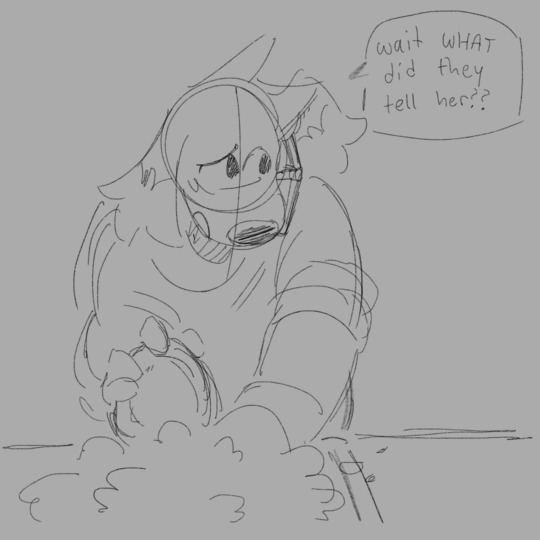
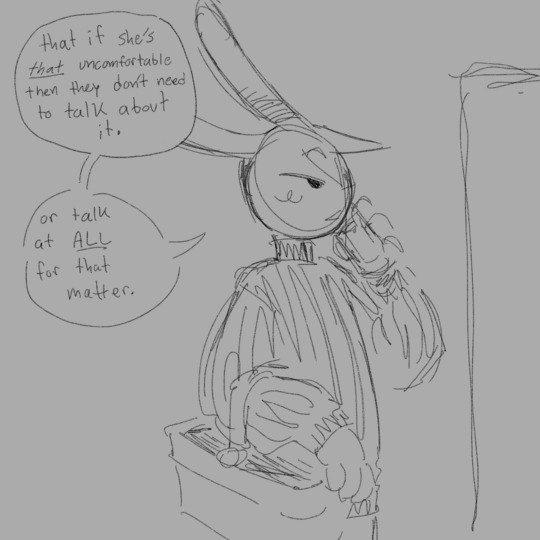
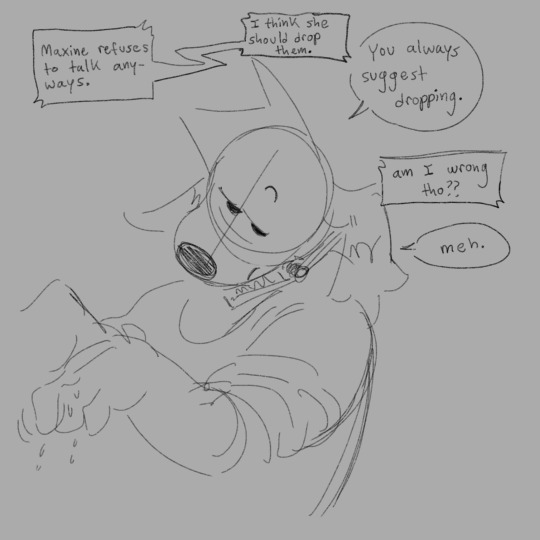
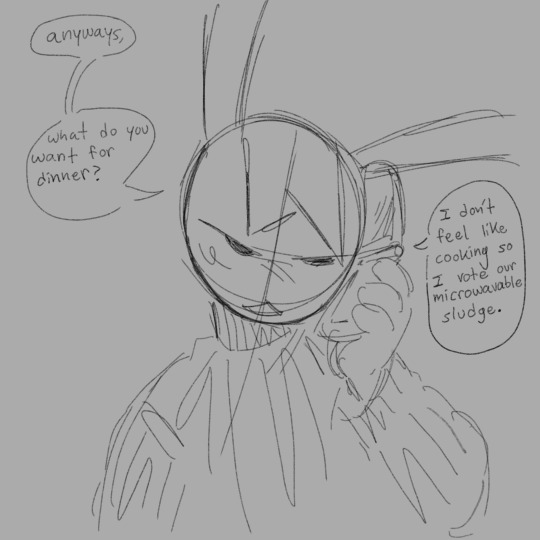

my base concept at the moment is that they’re really close roommates who go on adventures together. and if i had to be completely honest over the time i’ve had these two they developed more and more with being blatantly sam & max inspired without me even realizing it. (july was originally a cat. i had already thought about making them a bunny before i got into sam & max but as i became enamored with those two it basically solidified the decision.)
i kinda base them off my own dynamic with my long time childhood friend (now roommate)
besides that.. July is very hot headed and short tempered. very reckless. he’s just excited to do things in a very hostile manner. but he grounds himself quickly when it comes to Kindle and aids him in calming down from overthinking things or becoming anxious. very much willing to put his own shit aside to help those he cares about. takes care of others a lot and has a hard time letting others take care of them. he also really likes collecting rabbit/bunny memorabilia.
Kindle is very much Some Guy in my head. he’s a very run of the mill guy who’s just trying his best. as mentioned before he tends to clam up and get anxious a little more often than the average joe. has a hard time socializing and mostly has connections to others through July. very much autism. he likes cooking for people.
overall with their specific dynamic i take huge interest in exploring unique relationships people have with each other. i like to put the two in very affectionate posing but i don’t view them as explicitly romantic. though if others would like to i won’t yack their yum, yk. i just always love to push the boundaries of what ppl think separate a romantic relationship and a platonic one. maybe they’re not romantic nor platonic but a secret more sinister thing (joke).
other than that, here are some other concepts/doodles i’ve done!!
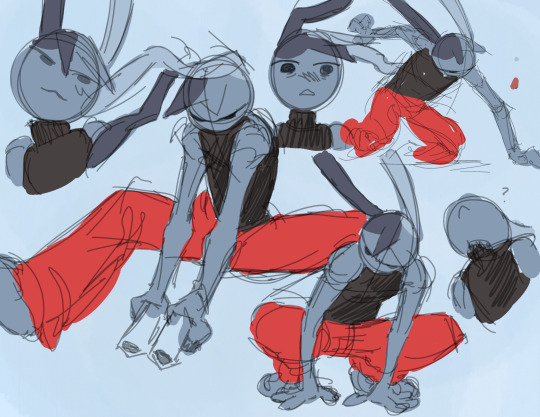
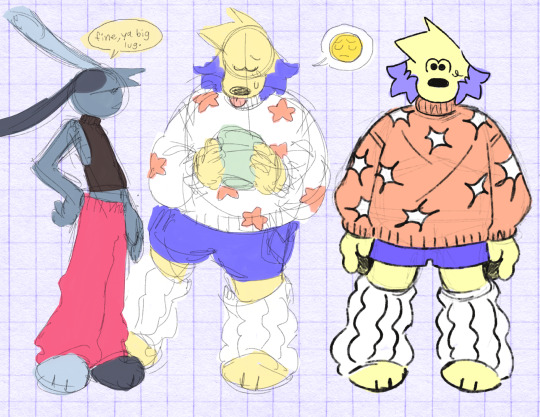
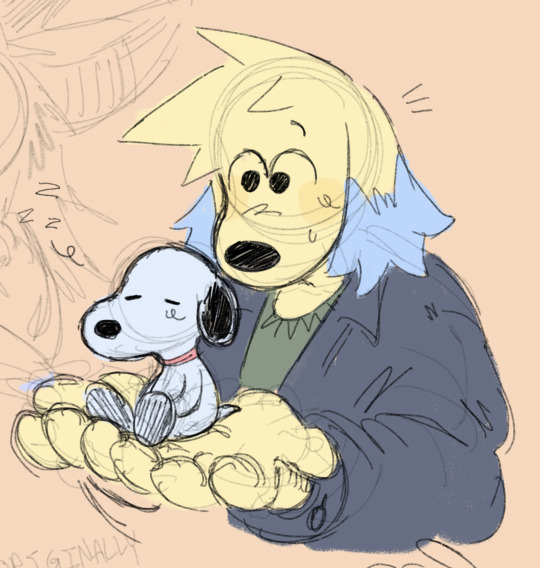
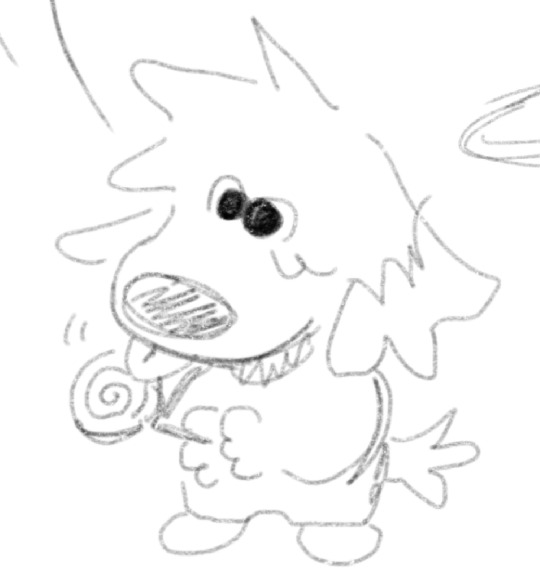

12 notes
·
View notes
Text
Overskill Kuden: The Teachings
There's a Japanese school of martial arts term known as "Kuden" which embraces the concept of "Mastering the Obvious".
It is the idea that one must fully understand one's self in order to achieve full mastery of the skills one obtains.
This concept was originally created in an anime series by the name of Log Horizon, however, the application of the concept itself goes far beyond an anime show.
The term "The Teachings" or "Skill of the Great Ones" (Kyojin no Waza) or "Boundary Destroying Arts" are other ways these "mysteries" have been described.
For an example of this Mastery, say you had a Special Attack that could be done in mid-air…
This ability not only suspends you IN the air, but it can also adjust your mid air momentum. For example, Bandit Revolver is a technique Sol can use in mid air to project himself forwards without the need to Airdash and spend that kind of resource, but it can also keep him in the air when he wants to delay a landing.
But there are other more "philosophical ways" of understanding this "mystery".
Combining two basic skills together to make a more advanced skill, or simply using the same skill for various different uses. Life Hacks can sometimes be described in this manner.
But it also applies to one's own sense of identity as well.
How you approach things, how you solve problems, how you view life… these things can change as YOU YOURSELF change and GROW.
Mastering "the obvious" about yourself. The things you might have easily missed when trying to understand your true potential.
To focus on the "inner meaning" of the concepts around you, the things that define you, and the things that carry the most meaning TO you.
Sometimes it is very easy to overlook the "obvious" in that sense.
Kuden: 口伝, is the inner mystery of yourself.
I hope you all can reflect on this and reconsider what needs to be mastered concerning yourselves.
3 notes
·
View notes
Text
LSAD Seminar 02: 3D Studies with Elaine Riordan - Part 2 (I ran out of space edition)
This was originally all included in my last post on the 3D Studies seminar, but I ran up against the "30 images per post" limit that our cruel overlords imposed upon us. Basically I want to run through the seven elements of 3D studies outlined in the seminar and share an artist, found through my own research, who I feel exemplifies that particular element.
Form

Louise Bourgeois
Louise Bourgeois is so renowned it almost feels like cheating to include her on a list like this, especially given the breadth of her work, incorporating many disciplines and techniques in her work. I chose Bourgeois for "form" as I feel she pushed the boundaries of what could be considered "form" as much as any artist ever has. Utilising mirrors like canvases, for example, makes us question where the form of a given piece lies. Similarly incorporating other elements such as structure, location, and space allowed her to express ideas in an entirely new way, unburdened by a dogmatic sense of what form "should" be. In this way Bourgeois' work broadened our understanding of what form.



Structure

Georges Vantongerloo
Georges Vantongerloo was a Belgian abstract sculptor and founding member of the "De Stijl" or Neoplasticism movement. Proponents of De Stijl advocated pure abstraction and universality by a reduction to the essentials of form and colour; they simplified visual compositions to vertical and horizontal, using only black, white and primary colors. This idea of using reduction to find an underlying meaning led him to explore structure in his art. Vantongerloo never achieved major success in life and is often considered to have been too devoted to his movement. But through his sacrificial nature we gained insight into the pure structural nature of art, and the truth and beauty found therein.




Texture

Anni Albers
"Besides surface qualities, such as rough and smooth, dull and shiny, hard and soft, textiles also includes colour, and, as the dominating element, texture, which is the result of the construction of weaves. Like any craft it may end in producing useful objects, or it may rise to the level of art."
A quote from the woman herself sums it up better than I ever could. Anni Albers is one of the most important textile artists there ever was. Her work elevated the standing of textile work in the art world and paved the way for the many artists to appear in her wake. Like many who work with 3D, she blurred the lines between art and design, gaining recognition for the traditionally feminine world of "craft" often excluded from the wider art world.



Volume

Bruno Catalano
Bruno Catalano is a Italian-French sculptor best known for his sculptures of figures with substantial sections missing. In my previous post I described the concept of "volume" in 3D studies as having to do with negative space, we must perceive an absence of some kind to truly grasp the volume of something. Much like the visual hollow of a glass informs its volume, Catalano's sculptures express volume specifically through their substantial missing portions. We as observers are forced to contemplate the "how" of a work, in such a way we would never need to with a conventional sculpture. Similarly Catalano's common practice of clothing his sculptures in everyday attire achieves the same effect in an additive manner, rather than a subtractive approach.

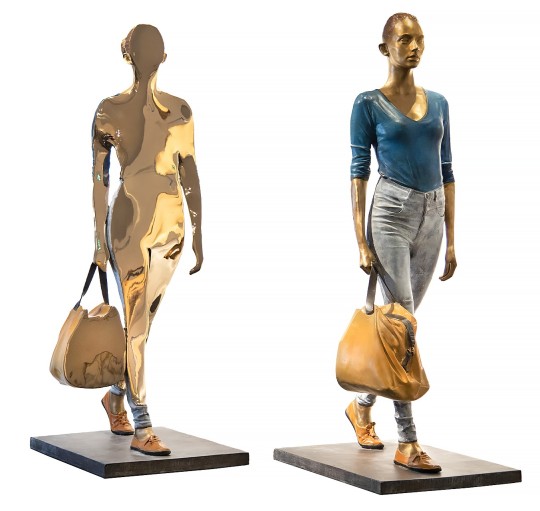

Weight
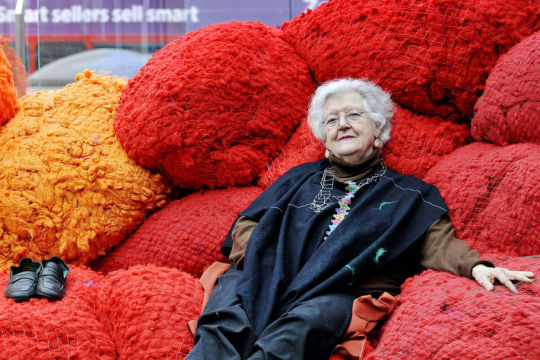
Sheila Hicks
Sheila Hicks is another who could reasonably be argued to define basically every element on this list. Her work is similar in ways to Anni Albers, whom I placed on this list under the category of "Texture". While Hicks works undoubtedly deals with texture, as it does sculpture, colour, and narrative among others, what has always stood out to me first and foremost about her work is it's sheer weight. Hicks is particularly known for the contrast in the scale of her works, ranging from minute to massive. What intrigues me though is how through her work, we see the minute become the massive. Common, lightweight elements like wool and string become enormous behemoths, stacked like rocks in galleries or flowing like waterfalls through ceiling installations. There are many artists who work with heavy material but few who convey weight regardless of material.




Space
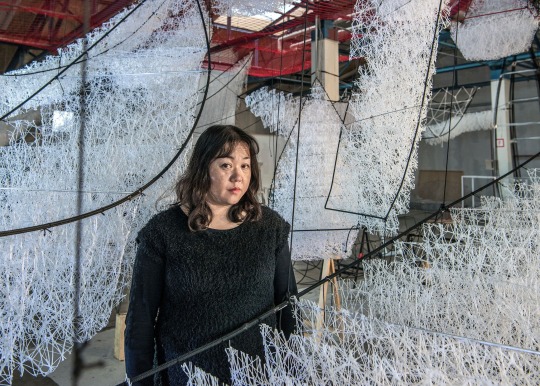
Chiharu Shiota
Chiharu Shiota was my immediate pick to exemplify the element of "space". Her work is not location-specific as it can be rearranged and displayed throughout many galleries but it is absolutely space-specific. Her installations dominate the space they occupy like few others. Shiota's work leverages the element of space to create ideas around the body and flesh, territory, and alienation. I feel there's not much else I can write here other than I'd love to visit an installation of hers one day and see the sheer scale of the space for myself.



Location

Lady Pink
I chose Lady Pink for the element of "location" as her signature graffiti work is deeply tied to her hometown of New York City and her identity therein. She began her career in graffiti in 1979 after the loss of her boyfriend, tagging his name across the city. I wrote in my last post that my understanding of location as an element, is that it's deeply attached to a work's context. Something so inextricably linked it would lose meaning were it removed from it's location. From the beginning Lady Pink's work has been inextricable from her life in New York.

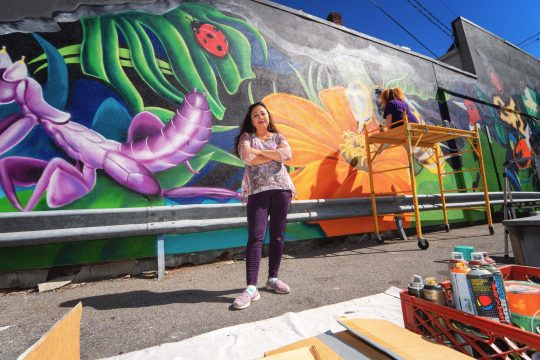
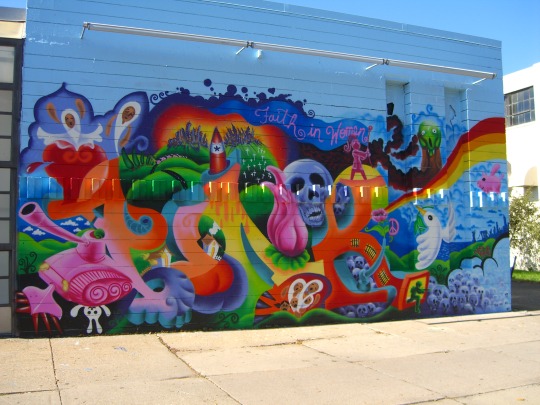
3 notes
·
View notes
Text
TECH 101 : Planning and Principles and Processes
The video explored the important subject of Planning Principles and Processes. The session was conducted by a faculty member of the Social Sciences Unit, who is an Economics degree holder, Ma'am Golda Salcedo. In a very practical and informative manner, our speaker took us through the significance of thoughtful planning, particularly in the entrepreneurial context. One of the most vivid concepts presented was the metaphor of remaining safe at home compared to risk-taking outdoors. In business, this is the process of making decisions regarding playing it safe or venturing into entrepreneurship. Venturing out, being risky, puts an individual out there amidst opportunities, contacts, strategy, and priceless life experiences. Entrepreneurial planning centers on this idea of understanding the risks but still venturing forth with a well-crafted plan.
Planning is not just jotting down a business concept. Planning is making educated decisions, considering possible problems, and establishing practical steps. Ma'am Salcedo reiterated that it takes more than money to start a business. For example, ₱100,000 is not sufficient if you don't have a clear plan, knowledge of your product, or a persuasive argument to prospective investors. The way you present your idea and the confidence you show in your product or service can greatly influence your success.
One major take home knowledge from this is to avoid underpriced products solely to keep pace with competitors. Reducing the price without regarding quality and expenditure can be devastating to your company in the end. Apple's case was mentioned to emphasize the fact that the customer pays not only for the price but also for the value, quality, and brand as well. Hence, pricing will always have to match the effort, uniqueness, and quality of your product. Ma'am Salcedo also emphasized the need for financial literacy. As business owners, it is crucial to learn the basics of accounting, permits, and taxes. Most potential business owners tend to ignore these factors, particularly in rural communities, which then results in avoidable setbacks.
Lastly, the session ended with a reminder: your business plan must have defined responsibilities, even if you're working for yourself. Good planning requires delegating tasks, establishing boundaries, and anticipating growth. This session was a reminder that in business, planning is not a choice, it is a requirement. Success starts not with an idea, but with the clarity and discipline to make that idea a sustainable reality.
0 notes
Text
Continuing. Champernowne’s constant is obvious transcendental in this definition; arranging all the decimal representations is the same as gsPotential permutations. These forms all write to the reals along the szK. Another way of saying this is through n-1, meaning the reduction from n which occurs for counting to occur because that is the 0-1-0, meaning you can see the n fit on the last 0.
Took a break. This is why the concept in a Liouville number works. Ah, I’m seeing this a bit better. Take the idea that root 2 minus a rational, which means a p over a q, is more than or equal to the inverse of q squared, meaning the area of the denominator. I have trouble seeing what that exactly means. I’ll go over it and see what happens: q is a count of gs, so this makes a grid or quadrant of a gsSheet, and that inverts into a gs, a CM1. The rest then is kinda obvious: p is greater than 1, so of course the inequality is greater. If p is less than 1, then a different result, but we’re counting out not in. That finally allows me to translate Liouville numbers as a gsProcess.
That was work. It only took a few minutes but it felt like hours. I’m getting spoiled.
You see why this is algebraic? Yes, manipulates gs layers in basic ruler manner, meaning it applies ru1. That doesn’t mean ru1 is algebraic only: counts Boundaries, counts whatever ru1 requires. It’s a room of requirements, a function of the construction and maintenance of xyR, meaning each sheet as a room generates and stays around through ru1. Like food is ru1 because some things are bad to eat. Or not the best choice.
You see why that becomes a limit? Yeah, if you have a p and a q, then there must be a p so x minus p/q is less than the inverse of q^n.
Forgot to post this. Now 21 Feb 2025. I want to make progress on defining the algebraic limit, but first I need to mention something I keep wanting to bring up but which slides out of my focus too fast for that to happen, which is this noticeable voice which says nope this isn’t happening or some similar negative when something is obviously happening. Like I’m literally on the bike and spinning up over 120 multiple times without skying my heartrate and there’s this voice saying nope this isn’t happening. I try to take it as disbelief, meaning the shedding of the negatives. Does that involve physical negatives, like the pain of making improvements is that as the goal of achieving that, at least attempting that because we can insert various effectiveness and efficiency measures, then the negatives shed include the D3-4 oh wow need a name for this, but need to grasp it better first.
So we have a D3-4 Thing in motion because it needs to progress to shed, though that can model as spin, because you can spin off different weights and attachment forms. I’m struck by the realization that if I’m accepting this is true, then Tizzies are true too. They are the Irreducibles, after all, because and this is an oh god when they pair in D3-4Space, that models as if they are each Irreducible to each other in the forms we’ve discussed, and that Irreducibility generates a specific Thing which Attaches to a specific End, so the Tizzies embody the Boundary in each direction of gsPairing, as that becomes 2 Things over or across the 1-0Segment Between the 2 Ends which are the circles, are the Boundaries which overlap - don’t lose the thread - so each is on the other’s Boundary, meaning each pairs over whatever the heck happens to each, which of course is true when it’s reduced in your head to Tizzies playing in the garden.
I also keep forgetting that some days ago I had the most intense sensation of seeing his face. I had been sorta thinking about how that required choice of voice was not specifically gendered and yet what happened was I needed to see myself in the male role, which you played so well. That was never that clear to me. You were such a goof.
So what name is that? It’s the material Pathway, which is part of the Actuality tracked in the Registry which records the reals along the szK. See the connection now? Transcendentals encode process beyond the algebraic to real values, to orderings which tell the story of that which makes that count here.
This is one flavor, as well, of why search is so hard: the infinite focus problem. Where is it encoded?
I also will forget that the last few days have seen a vast change in my knees, to the point where I’m now able to isolate the restrictions to areas in my calves which I’m now able to address. I’m seeing big improvements. And my conditioning: I have been finding intervals of 10 secs per minute too easy, meaning my heart rate is stable in the 130’s, so I changed it into bursts of over 120, relax, burst. I tried 4 times a minute but soon questioned my sanity. Settled on every 20 seconds, and that became minimum resistance of 1 keeping the rpm’s above 100 all the time with bursts over 120 as described. I was pleased to see my heart rate came down to around 140, dropping into the 130’s between bursts. I have almost too much energy.
Oh, and the severe pain in my neck is almost gone. I worked it out, which included some extremely painful moves, and now it’s that question about whether this is shedding negatives from the Actuality whose potential is shaped at least ‘potentially’ toward a favorable outcome so this is a negative state whose cost is necessary to achieve a long term better result, and that is perceived using the Observer conception which generates within gs. That’s gsPerspective: that in the formation of D3-4 Things there are connections to D4-3 Things. The gsProcess models as the IC of the 4 Boundaries.
That was said with a lot of confidence. Why? A simple gsPairing forms a disk. Leads directly to the conic sections, to the focusing of the ellipses, to the relation of each End on the Boundary over an End on the cone formed by the ideal fD-HG. That last, the parabolic, connects 2 Ends to something which happens connecting them, and thus what goes up must come down, at least in some sense. We talked about the limits of that with the Halting issue, which is through layers of triviality. After a few layers of triviality, the point, which is very hard to express, is that any values assigned, any description attached to the gsProcess beyond the existence of each stop won’t generate the prior results. See genetics.
So is it like the way genetics can put a tendency in but the transcendental makes it happen or not? I took another break. This isn’t coming together well enough for me. The connection to you has been weird. There was little sense of stimulation after the large breakthroughs of a few days ago, and then it came back this morning, only to fade away right as I was coming to an idea about transcendental numbers which would connect the concept of gsProcess over my objection to the reals. I haven’t been able to bridge that. How do I write this bridge?
Something connects here: gsProcess on one side and real numbers on the other. If we organize these by gsProcess, what does that mean? I’m seeing ru1 here because any rational is a count over the ruler of the denominator. I’ve been meaning to say ru1 acts within polynomial space, meaning 0Space because 1Space includes the Not choices. That’s in the definition of an Extent, that the Extent of the 1-0Segments into a 1-0Segment is the generation of the szK, which is the statement of the reals, even to Cantor’s definitions.
Beyond the rational are the algebraic irrationals, which obviously extend to the limit of 0Space. And then we’re into 1Space and that’s where I’m stuck. How exactly do I say that?
I’m stopping for the night. It’s now 22 Feb 2025.
0 notes
Text
October 28: It Follows
Watched It Follows today, which I’ve been meaning to rewatch for a while, after having seen it for the first time not long after it came out (10 years ago!!). It definitely holds up for me; in other words, yes, finally something really scary this year.
I am fairly uninterested in what IT is or stands for, honestly; metaphorical readings are not my area of expertise. I remember when the movie came out IT was compared to an STD, which is the obvious reading, but I find it somewhat boring. A little deeper than that is the concept of a loss of innocence: obviously that you can only become infected with IT, or even see IT through sex; but also that it kills through a sort of lewd pantomime of sexual activity; all of the references to sex and in particular to illicit, secretive, and/or tentative sexual activity (the dirty magazines, the first kisses, the backseat car sex, etc.). Also the references to a vague desire to escape or to reach beyond boundaries that, even when achieved, provides little in the way of actual satisfaction: much incoherent longing (to “just drive, maybe somewhere up North;” to cross from suburbs to city), little realization of actual freedom or meaningful movement. Something something growing up/coming of age etc. Additional placeholder text.
I’m more interested in why it’s an effective horror, especially since most of what I’m watching isn’t really hitting lately.
Being followed is intensely scary: I used to have nightmares about being chased so to me this is just an inherently terrifying concept, and I imagine for most people it is, because it’s a deeply fundamental fear. Something is after you and it’s going to keep coming and coming and coming. The design of it was great, too: the shape shifting/different forms, the manner of movement, the wrong-ness, to different degrees, of the various personae.
The style: the slow tracking shots; when there is movement and when there is stillness; how sometimes attention is drawn to IT and sometimes not, even to the degree that the characters themselves might not see IT; the haziness of the light; the wide pools of the unsaid, which is inherently disorienting; the building musical score and the silences.
On a related note, the dream-like ambiguity of the film: What year is it? The past, the future? Where are the parents? How old are the kids (I assume they’re college-aged, since they seem to talk about high school in the past tense, and that Jay is in maybe a community college class in the beginning—but it’s not super clear—at any rate, that they live with their parents but the parents are never seen makes them seem young but essentially ageless)? How is time passing? I find disorientation an essential part of good horror.
Psychological effects: One thing that was very interesting/striking to me on this watch was the way in which being exposed to IT changes a person forever. To get it to leave you alone you have to pass it to someone else: complicity, and complicity that potentially repeats and repeats. Passing it on involves having sex with someone, which means turning your own body into something you use, divorcing sex from human connection, even from basic pleasure (the only sex that seemed remotely pleasurable is the encounter between “Hugh” and Jay—her era of innocence.) When IT returns, you know it’s because the person you passed it to has died—are you a murderer for that? Is trying to help the person really only an act of selfishness, and how does one even “help”—“Hugh” perpetuates arguably the worst and most protracted violence of the film all in the name of ‘teaching’ Jay the stakes. Also, being constantly followed creates this intense and increasing paranoia, seen in both “Hugh” and Jay: you will see it for the rest of your life, even if it isn’t actively following you, but most other people won’t, leading you to question your own sanity, and because it can take many shapes, you will always be watching for it, always unsure of those around you, always with held breath.
Anyway, all of this to say: it’s death. It’s the knowledge of death that comes with coming of age, which is itself symbolized by sexual activity—terrifying in the mostly deep and fundamental way it is possible for something to terrify and yet you must also live with it, because it simply isn’t going anywhere, ever.
0 notes
Text
Unveiling the Immersive World of Digital Code Games
In the ever-evolving landscape of gaming, where virtual realms continuously expand and technology pushes boundaries, a new breed of games has emerged, captivating minds and challenging intellects: Digital Code Games. These games, often blending elements of puzzle-solving, strategy, and storytelling, offer players a unique opportunity to engage with the intricate world of coding while having fun.
Digital Code Games, also known as programming games or coding puzzles, provide a platform for players to learn, practice, and master coding skills in a playful and interactive manner. Unlike traditional programming tutorials or courses, these games gamify the learning process, making it more engaging and enjoyable for both beginners and seasoned developers alike.
One of the defining characteristics of 2k24 digital code is their accessibility. They cater to a wide range of audiences, from absolute beginners with no prior coding experience to experienced programmers looking to hone their skills or unwind with a stimulating challenge. Through intuitive interfaces and progressively challenging levels, these games gently introduce players to fundamental coding concepts such as loops, conditionals, variables, and functions, gradually building upon them to tackle more complex problems.
One shining example of the genre is "Human Resource Machine," developed by Tomorrow Corporation. Set in the corporate world, players assume the role of an office worker tasked with automating tasks using basic programming commands. As players progress through the game, they encounter increasingly complex challenges that require creative problem-solving and algorithmic thinking.xbox one games code
Another notable title is "RoboZZle," an online puzzle game where players program a robot to navigate through mazes using a simple programming language. With a vibrant community creating and sharing puzzles, RoboZZle offers endless opportunities for players to test their programming prowess and learn from one another.
The appeal of Digital Code Games extends beyond mere entertainment; they serve as powerful educational tools with immense potential for learning. By disguising coding lessons as engaging gameplay experiences, these games lower the barriers to entry for aspiring programmers and foster a culture of curiosity and experimentation.
Moreover, Digital Code Games promote valuable skills such as critical thinking, problem-solving, and perseverance. Players learn to approach problems methodically, breaking them down into smaller, manageable tasks—a skill that is not only essential in programming but also applicable to various real-world scenarios.Xbox sports game codes
In recent years, the popularity of Digital Code Games has surged, fueled by the growing demand for digital literacy and STEM education. Educators have begun incorporating these games into their curriculum, recognizing their effectiveness in teaching coding concepts in a way that resonates with students.
Furthermore, the rise of online platforms and communities dedicated to coding games has facilitated collaboration and knowledge-sharing among enthusiasts worldwide. Whether through competitive coding challenges or cooperative puzzle-solving, players come together to learn, grow, and push the boundaries of their coding abilities.
As we look to the future, the potential of Digital Code Games appears boundless. With advancements in technology and game design, we can expect even more immersive and innovative experiences that redefine how we learn and interact with code.
In conclusion, Digital Code Games represent a dynamic fusion of gaming and education, offering a gateway to the world of programming that is engaging, accessible, and endlessly rewarding. Whether you're a seasoned developer looking for a cerebral challenge or a curious beginner eager to embark on a coding journey, these games invite you to dive in and unlock the mysteries of the digital realm—one line of code at a time.
0 notes
Text
The Enduring Appeal of Educational Magnetic Building Blocks
In the realm of educational toys, few items have captured the imagination and creativity of children quite like magnetic building blocks. These colorful, versatile, and endlessly fascinating toys have become a staple in homes, classrooms, and daycare centers around the world. What is it about these magnetic marvels that make them so beloved? Let's dive into the captivating world of magnetic building blocks and explore their myriad benefits.
Unleashing Creativity
At the heart of magnetic building blocks lies the promise of limitless creativity. Children are naturally drawn to these toys, quite literally, as they snap magnetic pieces together to form all manner of structures, from simple towers to intricate castles and beyond. The tactile experience of handling these blocks, feeling the magnetic pull as they connect, sparks curiosity and encourages experimentation.
Hands-On Learning
Educational magnetic building blocks are not just about play; they are powerful tools for learning. Through hands-on exploration, children develop essential skills in spatial reasoning, problem-solving, and fine motor control. As they experiment with different arrangements and combinations, they learn fundamental principles of geometry and physics in a way that is both intuitive and engaging.
STEM Education in Action
In an age where STEM (Science, Technology, Engineering, and Mathematics) education is increasingly prioritized, magnetic building blocks serve as a gateway to these disciplines. Children learn about concepts like balance, symmetry, and stability as they construct and deconstruct their creations. Moreover, these toys can be used to teach more advanced topics such as architectural design and magnetic properties.
Building Confidence and Resilience
One of the less obvious benefits of magnetic building blocks is their role in building confidence and resilience in children. Every collapse or failed experiment is an opportunity for growth. Children learn that setbacks are a natural part of the creative process and develop the perseverance to try again, eventually mastering complex designs they once thought impossible.
Social and Emotional Development
Educational magnetic building blocks are also catalysts for social interaction. Whether children are collaborating on a grand construction project or engaging in friendly competitions, these toys foster teamwork and communication skills. Moreover, the sense of accomplishment that comes from completing a challenging build boosts self-esteem and nurtures a positive attitude towards learning.
Beyond the Basics
The appeal of magnetic building blocks extends far beyond their educational value. Many sets incorporate additional elements such as wheels, gears, and LED lights, further expanding the possibilities for imaginative play. Some sets even come with themed components that allow children to create scenes from their favorite stories or explore specific topics like outer space or medieval castles.
A Tool for All Ages
While magnetic building blocks are primarily associated with younger children, their appeal transcends age boundaries. Older kids and even adults can enjoy the challenge of more complex designs and the satisfaction of seeing their ideas come to life. In fact, magnetic building blocks have found a niche among hobbyists and educators alike who recognize their potential as tools for creative expression and conceptual exploration.
Choosing the Right Set
With so many options available, choosing the right magnetic building block set can seem daunting. Consider factors such as the age of the intended user, the size and variety of pieces, and any specific educational objectives. Quality is key; look for sets made from durable materials that can withstand enthusiastic play.
In Summary
Educational magnetic building blocks are more than just toys; they are instruments of discovery and empowerment. From fostering creativity and critical thinking to promoting social skills and resilience, these versatile playthings have earned their place in the pantheon of educational tools. As we continue to embrace the importance of hands-on learning and STEM education, magnetic building blocks stand ready to inspire the architects, engineers, and innovators of tomorrow.
0 notes
Text
Remote Work Revolution: Data Entry Jobs Explained [2024 Guide]

The landscape of work has undergone a seismic shift in recent years, accelerated by global events that have propelled remote work into the mainstream. Among the myriad opportunities for remote employment, data entry jobs have emerged as a popular choice for individuals seeking flexible work arrangements and the ability to work from anywhere. In this comprehensive guide, we'll explore the remote work revolution, delve into the world of data entry jobs, and provide insights into how individuals can thrive in this evolving industry in 2024.
1. The Rise of Remote Work
The concept of remote work has evolved from a niche practice to a widespread phenomenon, driven by advancements in technology, changing attitudes toward work-life balance, and the need for businesses to adapt to a rapidly changing world. The COVID-19 pandemic served as a catalyst, accelerating the adoption of remote work and demonstrating its feasibility on a large scale. As a result, remote work has become increasingly normalized, with many companies embracing remote or hybrid work models to attract and retain top talent.
2. Understanding Data Entry Jobs
Data entry jobs involve the inputting, processing, and management of data in various formats, such as text, numerical, or graphical. Common tasks include entering data into spreadsheets or databases, verifying accuracy, and organizing information in a structured manner. While data entry roles were traditionally office-based, the shift to remote work has opened up new opportunities for individuals to perform these tasks from the comfort of their own homes.
3. Skills and Qualifications
While data entry jobs typically don't require advanced degrees or specialized training, certain skills and qualifications can enhance one's prospects in the field. Proficiency in typing and keyboarding skills is essential, as data entry often involves entering large volumes of information quickly and accurately. Attention to detail, organizational skills, and the ability to work independently are also highly valued qualities in data entry professionals. Familiarity with data management software, spreadsheets, and basic computer skills are advantageous but can often be learned on the job or through online courses.
4. Finding Remote Data Entry Opportunities
The demand for remote data entry professionals has surged in recent years, with companies across various industries seeking individuals to assist with data processing and administrative tasks. Online job boards, freelance platforms, and remote work websites are valuable resources for finding remote data entry opportunities. Additionally, networking, reaching out to potential employers directly, and showcasing relevant skills and experience on professional profiles can increase visibility and attract remote job offers.
5. Navigating Remote Work Challenges
While remote work offers numerous benefits, such as flexibility and autonomy, it also presents unique challenges that individuals must navigate effectively. Common challenges include maintaining work-life balance, overcoming feelings of isolation, and staying motivated and productive without direct supervision. Establishing a dedicated workspace, setting boundaries between work and personal life, and prioritizing self-care are essential strategies for thriving in a remote work environment.
6. Embracing the Future of Work
As the remote work revolution continues to unfold, the future of data entry jobs and remote work, in general, remains promising. Advancements in technology, such as automation and artificial intelligence, may reshape the landscape of data entry roles, creating new opportunities for individuals with specialized skills in data analysis, interpretation, and decision-making. By staying adaptable, continuously upskilling, and embracing the opportunities presented by remote work, individuals can position themselves for success in the evolving job market of 2024 and beyond.
Conclusion
In conclusion, the remote work revolution has transformed the way we work, opening up new possibilities for individuals seeking flexible and remote employment opportunities. Data entry jobs represent one such avenue for remote work, offering individuals the chance to perform essential tasks from anywhere in the world. By understanding the nature of data entry roles, developing relevant skills, leveraging online resources to find remote job opportunities, and navigating remote work challenges effectively, individuals can embark on a fulfilling and rewarding career in data entry in the remote work era of 2024.
0 notes
Text
// Week 5: Digital Citizenship //

Digital Citizenship: Navigating the Intersection of Technology, Democracy, and Education
The emergence of the internet has led to significant transformations in civic participation, especially for individuals who utilise it as a means to engage with the world in innovative manners (Collin, 2015). The ability to change enables individuals to expand their influence into continuously growing networks of knowledge, establish relationships with unfamiliar communities, and engage in civic endeavours, both in the digital realm and in the physical world, that were previously unattainable in ordinary existence. Hence, there is a need to examine new ideas about citizenship that are not limited by geographical boundaries and instead emphasise global consciousness, analytical thinking, and a readiness to question established norms. This has led to the emergence of the concept known as the digital citizen (Bennett, Wells & Rank, 2009).
The concept of citizenship is complex, involving aspects of democracy, community, and education (Buchholz, DeHart & Moorman, 2020). Westheimer and Kahne (2004) provide a significant contribution to the discussion on citizenship education by identifying three main conceptions of the 'good citizen' as demonstrated in educational efforts: the personally responsible citizen, the participatory citizen, and the justice-oriented citizen. Expanding on this paradigm, current academic research (Krutka & Carpenter, 2017) has further developed these ideas to include the impact of digital tools and practices, as well as the new difficulties and possibilities that educators encounter in promoting democratic citizenship.
Contemporary citizenship requires individuals to possess digital literacy, which includes the skills of reading, writing, and interacting on digital platforms to connect with various online communities, all while prioritising social justice (Buchholz, DeHart & Moorman, 2020). Nevertheless, being a digital citizen goes beyond basic technological skills; it requires engaging with intricate concepts related to the formation of identities and communication in online environments, while actively working towards fairness and transformation in society.
One of the initial challenges in studying the concept of digital citizenship is the complexity of accurately recording and evaluating its various expressions in a significant way. This challenge encompasses not only comprehending how digital citizenship alters individuals' connections with established social structures and networks but also acknowledging how obstacles and limitations to digital access can impact citizens' roles and capabilities in the 21st century (Emejulu & McGregor, 2019). Hence, to fully grasp the concept of digital citizenship, it is necessary to examine the fundamental social interactions facilitated by technology and advocate for empowering actions that promote social equality.

Unpacking the Complexity of Digital Citizenship: Three Conditions for Advancement
Choi, Glassman, and Cristol (2017) have put forward three essential elements that are necessary for attaining a high level of digital citizenship.
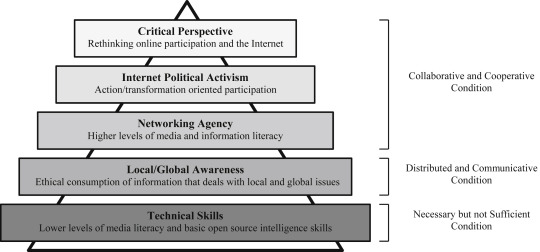
The primary requirement for digital citizenship, while not sufficient on its own, is centred on Technical Skills. Among these include the ability to effectively use various forms of media and information, as well as a solid foundation in open-source intelligence (Glassman & Kang, 2012). Proficiency in these skills establishes the fundamental structure for participating in different aspects of digital citizenship. People develop these technological skills by regularly using the internet without any mental effort or evaluation. This condition encompasses fundamental aspects of media and information literacy, as well as basic open-source skills, which enable effective engagement in online activities and purposeful strategic actions.
The second specified aspect of digital citizenship relates to proficiency in searching, organising, and evaluating information, which promotes increased levels of local and global awareness. Usually, when users engage with informative platforms like search engines, their interactions are one-sided, with users mostly consuming the information that is offered. There aren't many chances for critical interaction or collaborative knowledge-building projects, even if users can incorporate this data into their mental processes. Within the area of traditional trade, the widespread availability of the Internet provides customers with greater opportunities to explore a wide range of choices and gain more comprehensive knowledge about competing options while making purchasing selections.
Interactions between users' participation in online communities and their capacity to work together cooperatively constitute the third and final component of digital citizenship complications. This engagement enhances personal cognitive abilities and group efforts, expanding users' inclination and ability to interact with others, participate in meaningful discussions, and engage in political activity on digital platforms.
The concept of digital citizenship is shown as a dynamic and multidimensional idea that is inextricably connected to individuals' daily activities, whether they are conducted online or offline. It adapts in sync with the changing digital interactions and demonstrates a dynamic interaction between different levels of participation (Choi, Glassman & Cristol, 2017).
References
Bennett, WL, Wells, C & Rank, A 2009, ‘Young Citizens and Civic learning: Two Paradigms of Citizenship in the Digital Age’, Citizenship Studies, vol. 13, no. 2, pp. 105–120.
Buchholz, BA, DeHart, J & Moorman, G 2020, ‘Digital Citizenship during a Global Pandemic: Moving beyond Digital Literacy’, Journal of Adolescent & Adult Literacy, vol. 64, no. 1, Wiley-Blackwell, pp. 11–17.
Choi, M, Glassman, M & Cristol, D 2017, ‘What It Means to Be a Citizen in the Internet age: Development of a Reliable and Valid Digital Citizenship Scale’, Computers & Education, vol. 107, Elsevier BV, pp. 100–112.
Collin, P 2015, ‘The Civic web: Young people, the Internet and Civic Participation’, Information, Communication & Society, vol. 18, no. 12, pp. 1464–1466.
Emejulu, A & McGregor, C 2019, ‘Towards a Radical Digital Citizenship in Digital Education’, Critical Studies in Education, vol. 60, no. 1, pp. 131–147.
Glassman, M & Kang, MJ 2012, ‘Intelligence in the Internet age: the Emergence and Evolution of Open Source Intelligence (OSINT)’, Computers in Human Behavior, vol. 28, no. 2, Elsevier BV, pp. 673–682.
Krutka, DG & Carpenter, JP 2017, ‘Digital Citizenship in the Curriculum.’, Educational Leadership, vol. 75, no. 3, ASCD. 1703 North Beauregard Street, Alexandria, VA 22311-1714. Tel: 800-933-2723; Tel: 703-578-9600; Fax: 703-575-5400; Web site: http://www.ascd.org, pp. 50–55.
Westheimer, J & Kahne, J 2016, ‘What Kind of Citizen? The Politics of Educating for Democracy’, American Educational Research Journal, vol. 41, no. 2, pp. 237–269.
0 notes